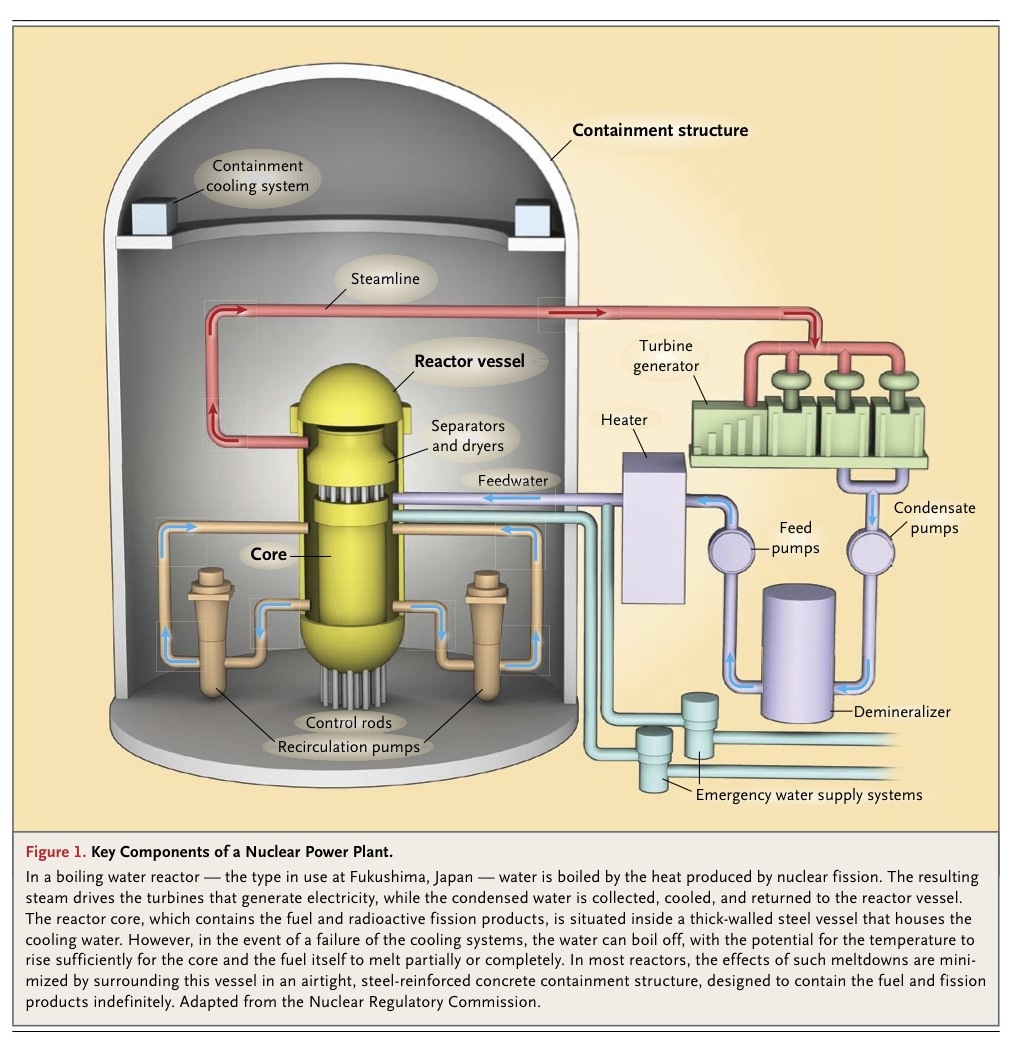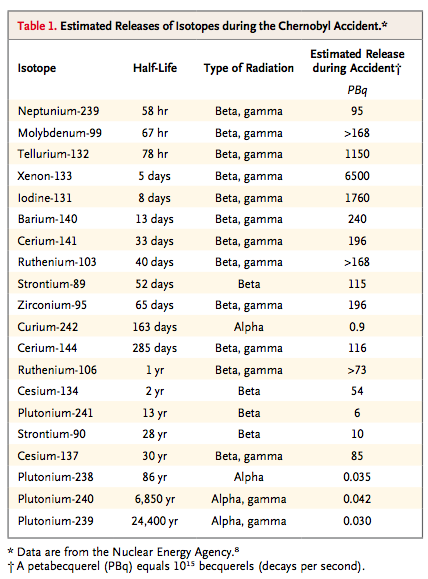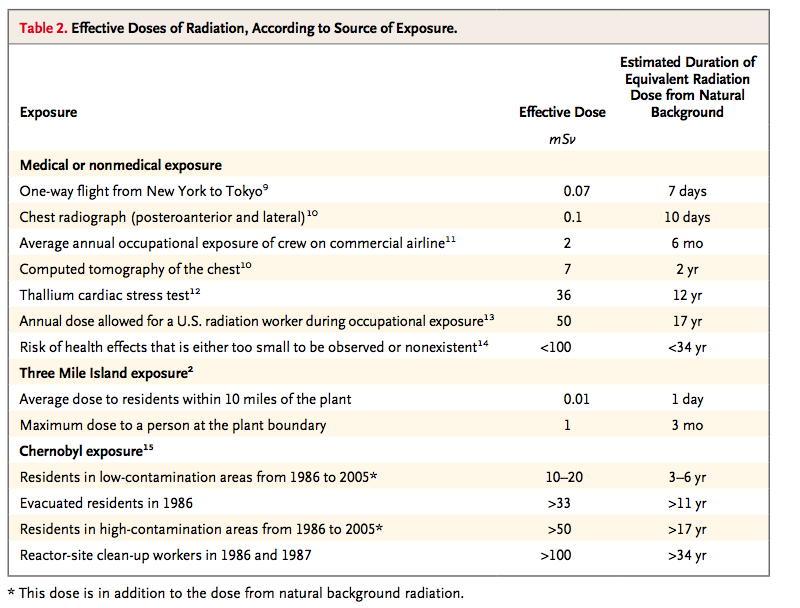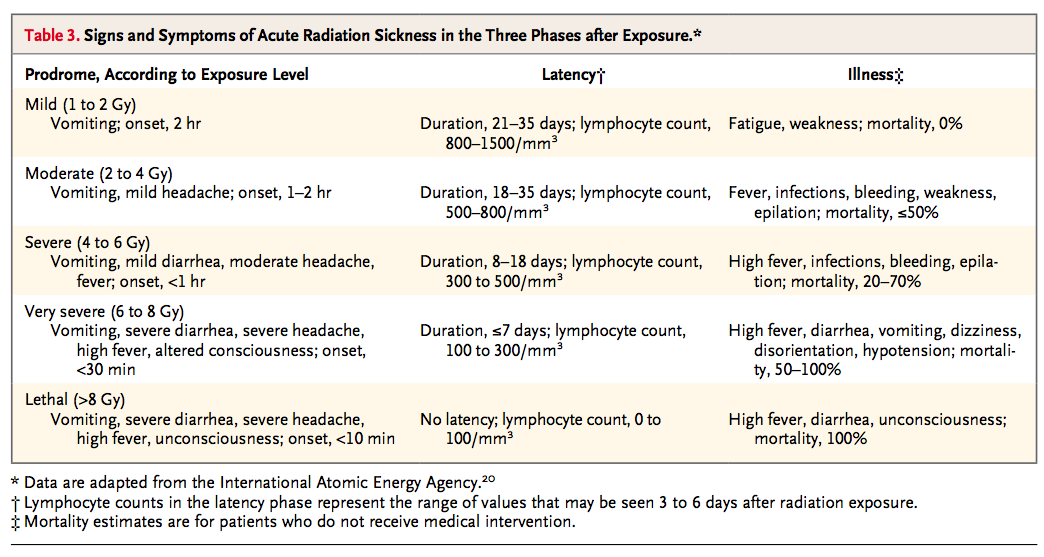John P. Christodouleas, M.D., M.P.H., Robert D. Forrest, C.H.P., Christopher G. Ainsley, Ph.D., Zelig Tochner, M.D., Stephen M. Hahn, M.D., and Eli Glatstein, M.D.
N Engl J Med 2011; 364:2334-2341
On March 11, 2011, a 9.0-magnitude earthquake struck the east coast of Japan. The total number of people who died in the earthquake and the tsunami that it generated is still being assessed, but the official estimation already exceeds 14,000.1 The natural disaster also caused substantial damage to the Fukushima Daiichi nuclear power plant, the consequences of which are still unclear. The purpose of this review is to put the emergency at the Japanese power plant, even as it is evolving, into the context of the extensive literature on nuclear-reactor accidents by analyzing the mechanisms and major short-term and long-term health risks of radiation exposure. In addition, we briefly discuss the accidents at Three Mile Island in Pennsylvania in 1979 and at Chernobyl in Ukraine in 1986 because they illustrate the broad range of potential outcomes.
Reactor Accidents and the Release of Radioactive Materials
In a nuclear power plant, the fuel, an isotope of either uranium or plutonium, undergoes fission to produce the energy that is used to heat water and turn steam-driven turbine generators. In addition to the release of energy, the split fuel creates radioactive fission products. In the event of an accident, the primary concern is that the support structure (core) containing the fuel and the fission products may become damaged and allow radioactive elements to escape into the environment. One mechanism by which this can happen is failure of the core cooling system. In such a circumstance, the reactor core and even the fuel itself can partially or completely melt. Elevated temperatures and pressures can result in explosions within the reactor, dispersing radioactive material. In most plants, the potential effects of a cooling-system failure are minimized by surrounding the reactor core with a steel-walled vessel, which in turn is surrounded by an airtight, steel-reinforced concrete containment structure that is designed to contain the radioactive material indefinitely. Of note, the explosions that have been seen in reactor accidents are not the same as those seen after the detonation of a nuclear weapon, since the latter requires highly enriched uranium or plutonium isotopes in concentrations and configurations that are not present in power plants.

In the partial meltdown at Three Mile Island, the plant's containment structure fulfilled its purpose, and a minimal amount of radiation was released.2 However, there was no such containment structure in place at the Chernobyl reactor — the explosions and the subsequent fire sent a giant plume of radioactive material into the atmosphere. Although the Three Mile Island accident has not yet led to identifiable health effects,3-5 the Chernobyl accident resulted in 28 deaths related to radiation exposure in the year after the accident.6,7 The long-term effects of the Chernobyl accident are still being characterized, as we discuss in more detail below. The situation at Fukushima, though still in daily flux, will probably end up ranking between these two historical accidents in terms of radiation releases and health consequences.
table1 lists the radioisotopes that were released during the Chernobyl accident.8 The health threat from each radioisotope depends on an assortment of factors. Radioisotopes with a very short half-life (e.g., 67 hours for molybdenum-99) or a very long half-life (e.g., 24,400 years for plutonium-239), those that are gaseous (e.g., xenon-133), and those that are not released in substantial quantities (e.g., plutonium-238) do not cause substantial internal or external contamination in reactor accidents. In contrast, iodine-131 can be an important source of morbidity because of its prevalence in reactor discharges and its tendency to settle on the ground. When iodine-131 is released, it can be inhaled or consumed after it enters the food chain, primarily through contaminated fruits, vegetables, milk, and groundwater.Once it enters the body, iodine-131 rapidly accumulates in the thyroid gland, where it can be a source of substantial doses of beta radiation.
The release of radioactive water into the sea at the Fukushima plant has resulted in an additional route whereby the food chain may be affected, through contaminated seafood. Although the radioactivity in seawater close to the plant may be transiently higher than usual by several orders of magnitude, it diffuses rapidly with distance and decays over time, according to half-life, both before and after ingestion by marine life.
table2 shows estimated effective doses received during common medical and nonmedical activities and how these doses relate to those received by the populations around Three Mile Island and Chernobyl.9-15
Radiation exposure can potentially result in short-term and long-term effects in every organ system in the body. Comprehensive reviews of the literature on radiation exposure have been produced by the International Atomic Energy Agency and the World Health Organization.7,15 In this review, we focus on the two potential outcomes of radiation exposure that have garnered much of the media attention in the wake of the ongoing crisis in Fukushima: acute radiation sickness and increased long-term cancer risks.
Acute Radiation Sickness and Its Treatment
When most or all of the human body is exposed to a single dose of more than 1 Gy of radiation, acute radiation sickness can occur. Much of our understanding of acute radiation sickness is based on the clinical experience of more than 800 patients who have been described in national and international registries of radiation accidents that have been predominantly medical in source.16Acute radiation sickness has not been seen in the general population in association with a nuclear-reactor accident. All 134 patients with confirmed acute radiation sickness at Chernobyl were either plant workers or members of the emergency response team.6 No confirmed diagnoses of acute radiation sickness were noted in workers or in the general population at Three Mile Island.17
Much of the short-term morbidity and mortality associated with a high total or near-total body dose is due to hematologic, gastrointestinal, or cutaneous sequelae. In the Chernobyl accident, all 134 patients with acute radiation sickness had bone marrow depression, 19 had widespread radiation dermatitis, and 15 had severe gastrointestinal complications.18 Hematologic and gastrointestinal complications are common because bone marrow and intestinal epithelium are especially radiosensitive as a result of their high intrinsic replication rate. Cutaneous toxic effects are common because external low-energy gamma radiation and beta radiation are chiefly absorbed in the skin. In Chernobyl, estimated skin doses in some patients were 10 to 30 times the bone marrow doses.18 If total body doses are extremely high (>20 Gy), severe acute neurovascular compromise can occur. At Chernobyl, the highest absorbed dose in a worker was 16 Gy.19
Acute radiation sickness can be categorized into three phases: prodrome, latency, and illness.
summarizes the constellation of hematologic, gastrointestinal, and neurologic symptoms, along with the time to onset and dose dependence, associated with each of these phases. Cutaneous manifestations of acute radiation injury include mild erythema and pruritus with limited skin doses (3 to 15 Gy) and blistering and ulceration with very high skin doses (>15 Gy).6
The first step in the care of any patient who is exposed to radiation is to manage immediate life-threatening injuries, such as those from trauma or burns. The next step is to address external and internal radiation contamination, if any. Decontamination protocols are available from several sources.20,21 Once these issues have been addressed and acute radiation sickness is suspected, treatment is guided by the estimated total dose, which is determined on the basis of the initial clinical symptoms, lymphocyte depletion kinetics, and cytogenetic analyses, when available.22,23
Patients with modest whole-body doses (<2 Gy) may require only symptomatic support for nausea and vomiting. In patients with whole-body doses of more than 2 Gy, the treatment of the consequences of bone marrow depletion is paramount. Strategies include management of infections with antibiotics and antiviral and antifungal agents, the use of hematopoietic growth factors, and possibly bone marrow transplantation.20 The use of bone marrow transplantation is controversial, since outcomes after radiation accidents have been poor. After Chernobyl, only 2 of the 13 patients who underwent bone marrow transplantation survived long term. Among the 11 patients who died, complications from transplantation appeared to be the primary cause of death in 2 patients.24Gastrointestinal radiation sequelae are managed with supportive care and possibly with the use of prophylactic probiotics.25 Cutaneous radiation injuries may evolve over the course of weeks. Treatment of such lesions involves minimizing acute and chronic inflammation with topical glucocorticoids while avoiding secondary infections. Several organizations have developed detailed treatment algorithms for acute radiation sickness that are publicly available.6,20,26,27
Increased Long-Term Cancer Risks
In the region around Chernobyl, more than 5 million people may have been exposed to excess radiation, mainly through contamination by iodine-131 and cesium isotopes.7 Although exposure to nuclear-reactor fallout does not cause acute illness, it may elevate long-term cancer risks. Studies of the Japanese atomic-bomb survivors showed clearly elevated rates of leukemia and solid cancers, even at relatively low total body doses.28,29 However, there are important differences between the type of radiation and dose rate associated with atomic-bomb exposure and those associated with a reactor accident. These differences may explain why studies evaluating leukemia30-36– and nonthyroid solid cancers37-40– have not shown consistently elevated risks in the regions around Chernobyl. Alternatively, small increases in the risks of leukemia and nonthyroid solid cancers may become more apparent with improved cancer registries or longer follow-up. In the population around Three Mile Island, there was a notable temporary increase in cancer diagnoses in the years immediately after the accident, but this increase may have been the result of intensified cancer screening in the area. Long-term follow-up has shown no increases in cancer mortality.4
However, there is strong evidence of an increased rate of secondary thyroid cancers among children who have ingested iodine-131. Careful studies of children living near the Chernobyl plant (which included estimates of the thyroid radiation dose) suggest that the risk of thyroid cancer increased by a factor of 2 to 5 per 1 Gy of thyroid dose.41-43 Although this relative increase in incidence is large, the baseline incidence of thyroid cancer in children is low (<1 case per 100,000 children). Factors that increase the carcinogenic effect of iodine-131 include a young age and iodine deficiency at the time of exposure. Among children in regions with endemic iodine deficiency, the risk of thyroid cancer per 1 Gy of thyroid dose was two to three times that among children in regions in which iodine intake was normal.44,45 Moreover, the risk of thyroid cancer among children who were given stable iodine after the Chernobyl accident was one third that among children who did not receive iodine.45 Studies of the effect of thyroid exposure to radiation in utero46,47 and in adulthood48-50 have been inconclusive.
In accidents in which iodine-131 is released, persons in affected areas should attempt to minimize their consumption of locally grown produce and groundwater. However, since the half-life of iodine-131 is only 8 days, these local resources should not contain substantial amounts of iodine-131 after 2 to 3 months. On the advice of public health officials, area residents may take potassium iodide to block the uptake of iodine-131 in the thyroid. To be most effective, prophylactic administration of potassium iodide should occur before or within a few hours after iodine-131 exposure. The administration of the drug more than a day after exposure probably has limited effect, unless additional or continuing exposure is expected.51 Although potassium iodide can have toxic effects, the Polish experience with en masse administration of the drug after Chernobyl was reassuring. More than 10 million children and adolescents in Poland were given a single dose of prophylactic potassium iodide, with very limited morbidity.52 The Food and Drug Administration has issued guidelines for the administration of potassium iodide according to age and expected radiation exposure.53
你也可以參考這篇比較簡單的:
簡單認識放射性物質與治療
REFERENCES
. 1 Damage situation and police countermeasures associated with 2011 Tohoku district — off the Pacific Ocean earthquake. Tokyo: National Police Agency of Japan, Emergency Disaster Countermeasure Headquarters, April 19, 2011. (In Japanese.) (http://www.npa.go.jp/archive/keibi/biki/higaijokyo_e.pdf.)
. 2 Backgrounder on the Three Mile Island accident. Washington, DC: Nuclear Regulatory Commission, 2009. (http://www.nrc.gov/reading-rm/doc-collections/fact-sheets/3mile-isle.html.)
. 3 Hatch MC, Wallenstein S, Beyea J, Nieves JW, Susser M. Cancer rates after the Three Mile Island nuclear accident and proximity of residence to the plant. Am J Public Health 1991;81:719-724 CrossRef | Web of Science | Medline
. 4 Talbott EO, Youk AO, McHugh-Pemu KP, Zborowski JV. Long-term follow-up of the residents of the Three Mile Island accident area: 1979-1998. Environ Health Perspect 2003;111:341-348[Erratum, Environ Health Perspect 2003;111:A453.] CrossRef | Web of Science | Medline
. 5 Levin RJ. Incidence of thyroid cancer in residents surrounding the Three Mile Island nuclear facility. Laryngoscope 2008;118:618-628 CrossRef | Web of Science | Medline
. 6 Follow up of delayed health consequences of acute accidental radiation exposure. Vienna: International Atomic Energy Agency, 2002. (IAEA publication no. IAEA-TECDOC-1300.) (http://www-pub.iaea.org/mtcd/publications/pdf/te_1300_web.pdf.)
. 7 Chernobyl's legacy: Health, environmental and socio-economic impacts. Vienna: International Atomic Energy Agency, 2006. (IAEA publication no. IAEA/PI/A.87 Rev.2 / 06-0918.) (http://www.iaea.org/Publications/Booklets/Chernobyl/chernobyl.pdf.)
. 8 Chernobyl: assessment of radiological and health impacts. 2002 Update of Chernobyl: ten years on. Paris: Nuclear Energy Agency of the Organization for Economic Cooperation and Development, 2003. (http://www.oecd-nea.org/rp/chernobyl/.)
. 9 Friedberg W, Copeland K. What aircrews should know about their occupational exposure to ionizing radiation. Springfield, VA: National Technical Information Service, October, 2003. (NTIS publication no. DOT/FAA/AM-03/16.) (http://www.faa.gov/library/reports/medical/oamtechreports/2000s/media/0316.pdf.)
. 10 Hall EJ. Radiobiology for the radiologist. 5th ed. Philadelphia: Lippincott Williams & Wilkins, 2000:208.
. 11 Feng YJ, Chen WR, Sun TP, Duan SY, Jia BS, Zhang HL. Estimated cosmic radiation doses for flight personnel. Space Med Med Eng (Beijing) 2002;15:265-269 Medline
. 12 Radiation dose to patients from radiopharmaceuticals (addendum 2 to ICRP publication 53). Ann ICRP 1998;28;1-126.
. 13 Standards for protection against radiation: occupational dose limits. 10 C.F.R. pt. 20 (1991). Washington, DC: Nuclear Regulatory Commission. (http://www.nrc.gov/reading-rm/doc-collections/cfr/part020/part020-1201.html.)
. 14 Radiation risk in perspective. McLean, VA: Health Physics Society, 2010. (HPS publication no. PS010-2.) (http://hps.org/documents/risk_ps010-2.pdf.)
. 15 Health effects of the Chernobyl accident and special health care programmes. Geneva: World Health Organization, 2006. (http://www.who.int/ionizing_radiation/chernobyl/who_chernobyl_report_2006.pdf.)
. 16 Friesecke I, Beyrer K, Wedel R, Reimers K, Fliedner TM. SEARCH: a system for evaluation and archiving of radiation accidents based on case histories. Radiat Environ Biophys 2000;39:213-217 CrossRef | Web of Science | Medline
. 17 Kemeny JG, ed. Report of the President's Commission on the Accident at Three Mile Island. Washington, DC: Government Printing Office, 1980.
. 18 Mettler FA Jr, Gus'kova AK, Gusev I. Health effects in those with acute radiation sickness from the Chernobyl accident. Health Phys 2007;93:462-469 CrossRef | Web of Science | Medline
. 19 United Nations Scientific Committee on the Effects of Atomic Radiation. Sources and effects of ionizing radiation: UNSCEAR 2000 report to the General Assembly, with scientific annexes: annex J. New York: United Nations, 2000. (http://www.unscear.org/docs/reports/annexj.pdf.)
. 20 Diagnosis and treatment of radiation injuries. Safety series no. 2. Vienna: International Atomic Energy Agency, 1998. (http://www-pub.iaea.org/MTCD/publications/PDF/P040_scr.pdf.)
. 21 Tochner ZA, Glatstein E. Radiation bioterrorism. In: Fauci AS, Braunwald E, Kasper DL, et al., eds. Harrison's principles of internal medicine. 17th ed. New York: McGraw-Hill Medical, 2008:1358-64.
. 22 Weinstock DM, Case C Jr, Bader JL, et al. Radiologic and nuclear events: contingency planning for hematologists/oncologists. Blood 2008;111:5440-5445 CrossRef | Web of Science | Medline
. 23 Fliedner TM, Powles R, Sirohi B, Niederweiser D. Radiologic and nuclear events: the METREPOL severity of effect grading system. Blood 2008;111:5757-5758 CrossRef | Web of Science | Medline
. 24 Baranov A, Gale RP, Guskova A, et al. Bone marrow transplantation after the Chernobyl nuclear accident. N Engl J Med 1989;321:205-212[Erratum, N Engl J Med 1990;322:280.] Full Text | Web of Science | Medline
. 25 Korschunov VM, Smeianov VV, Efimov BA, Tarabrina NP, Ivanov AA, Baranov AE. Therapeutic use of an antibiotic-resistant Bifidobacterium preparation in men exposed to high-dose gamma-irradiation. J Med Microbiol 1996;44:70-74 CrossRef | Web of Science | Medline
. 26 Medical management of radiological casualties. Bethesda, MD: Armed Forces Radiobiology Research Institute, 2010. (http://www.usuhs.mil/afrri/outreach/pdf/3edmmrchandbook.pdf.)
. 27 Radiation emergency medical management. Bethesda, MD: National Library of Medicine, 2011. (http://www.remm.nlm.gov.)
. 28 Preston DL, Kusumi S, Tomonaga M, et al. Cancer incidence in atomic bomb survivors. Part III. Leukemia, lymphoma and multiple myeloma, 1950-1987. Radiat Res 1994;137:S68-97[Erratum, Radiat Res 1994;139:129.] CrossRef | Web of Science | Medline
. 29 Preston DL, Ron E, Tokuoka S, et al. Solid cancer incidence in atomic bomb survivors: 1958-1998. Radiat Res 2007;168:1-64 CrossRef | Web of Science | Medline
. 30 Petridou E, Trichopoulos D, Dessypris N, et al. Infant leukaemia after in utero exposure to radiation from Chernobyl. Nature 1996;382:352-353 CrossRef | Web of Science | Medline
. 31 Steiner M, Burkart W, Grosche B, Kaletsch U, Michaelis J. Trends in infant leukaemia in West Germany in relation to in utero exposure due to Chernobyl accident. Radiat Environ Biophys 1998;37:87-93 CrossRef | Web of Science | Medline
. 32 Parkin DM, Clayton D, Black RJ, et al. Childhood leukaemia in Europe after Chernobyl: 5 year follow-up. Br J Cancer 1996;73:1006-1012 CrossRef | Web of Science | Medline
. 33 Noshchenko AG, Zamostyan PV, Bondar OY, Drozdova VD. Radiation-induced leukemia risk among those aged 0-20 at the time of the Chernobyl accident: a case-control study in the Ukraine. Int J Cancer 2002;99:609-618 CrossRef | Web of Science | Medline
. 34 Konogorov AP, Ivanov VK, Chekin SY, Khait SE. A case-control analysis of leukemia in accident emergency workers of Chernobyl. J Environ Pathol Toxicol Oncol 2000;19:143-151 Medline
. 35 Romanenko AY, Finch SC, Hatch M, et al. The Ukrainian-American study of leukemia and related disorders among Chornobyl cleanup workers from Ukraine: III. Radiation risks. Radiat Res 2008;170:711-720 CrossRef | Web of Science | Medline
. 36 Kesminiene A, Evrard AS, Ivanov VK, et al. Risk of hematological malignancies among Chernobyl liquidators. Radiat Res 2008;170:721-735 CrossRef | Web of Science | Medline
. 37 Ivanov V, Ilyin L, Gorski A, Tukov A, Naumenko R. Radiation and epidemiological analysis for solid cancer incidence among nuclear workers who participated in recovery operations following the accident at the Chernobyl NPP. J Radiat Res (Tokyo) 2004;45:41-44 CrossRef | Web of Science | Medline
. 38 Ivanov VK, Gorski AI, Tsyb AF, Ivanov SI, Naumenko RN, Ivanova LV. Solid cancer incidence among the Chernobyl emergency workers residing in Russia: estimation of radiation risks. Radiat Environ Biophys 2004;43:35-42 CrossRef | Web of Science | Medline
. 39 Pukkala E, Kesminiene A, Poliakov S, et al. Breast cancer in Belarus and Ukraine after the Chernobyl accident. Int J Cancer 2006;119:651-658 CrossRef | Web of Science | Medline
. 40 Bogdanova NV, Antonenkova NN, Rogov YI, Karstens JH, Hillemanns P, Dork T. High frequency and allele-specific differences of BRCA1 founder mutations in breast cancer and ovarian cancer patients from Belarus. Clin Genet 2010;78:364-372 CrossRef | Web of Science | Medline
. 41 Tronko MD, Howe GR, Bogdanova TI, et al. A cohort study of thyroid cancer and other thyroid diseases after the Chornobyl accident: thyroid cancer in Ukraine detected during first screening. J Natl Cancer Inst 2006;98:897-903 CrossRef | Web of Science | Medline
. 42 Zablotska LB, Ron E, Rozhko AV, et al. Thyroid cancer risk in Belarus among children and adolescents exposed to radioiodine after the Chornobyl accident. Br J Cancer 2011;104:181-187 CrossRef | Web of Science | Medline
. 43 Brenner AV, Tronko MD, Hatch M, et al. I-131 Dose-response for incident thyroid cancers in Ukraine related to the Chornobyl accident. Environ Health Perspect 2011 March 14 (Epub ahead of print).
. 44 Shakhtarin VV, Tsyb AF, Stepanenko VF, Orlov MY, Kopecky KJ, Davis S. Iodine deficiency, radiation dose, and the risk of thyroid cancer among children and adolescents in the Bryansk region of Russia following the Chernobyl power station accident. Int J Epidemiol 2003;32:584-591 CrossRef | Web of Science | Medline
. 45 Cardis E, Kesminiene A, Ivanov V, et al. Risk of thyroid cancer after exposure to 131I in childhood. J Natl Cancer Inst 2005;97:724-732 CrossRef | Web of Science | Medline
. 46 Shibata Y, Yamashita S, Masyakin VB, Panasyuk GD, Nagataki S. 15 Years after Chernobyl: new evidence of thyroid cancer. Lancet 2001;358:1965-1966 CrossRef | Web of Science | Medline
. 47 Hatch M, Brenner A, Bogdanova T, et al. A screening study of thyroid cancer and other thyroid diseases among individuals exposed in utero to iodine-131 from Chernobyl fallout. J Clin Endocrinol Metab 2009;94:899-906 CrossRef | Web of Science | Medline
. 48 Ivanov VK, Tsyb AF, Petrov AV, Maksioutov MA, Shilyaeva TP, Kochergina EV. Thyroid cancer incidence among liquidators of the Chernobyl accident: absence of dependence of radiation risks on external radiation dose. Radiat Environ Biophys 2002;41:195-198 Web of Science | Medline
. 49 Ivanov VK, Gorski AI, Maksioutov MA, et al. Thyroid cancer incidence among adolescents and adults in the Bryansk region of Russia following the Chernobyl accident. Health Phys 2003;84:46-60 CrossRef | Web of Science | Medline
. 50 Ivanov VK, Chekin SY, Kashcheev VV, Maksioutov MA, Tumanov KA. Risk of thyroid cancer among Chernobyl emergency workers of Russia. Radiat Environ Biophys 2008;47:463-467 CrossRef | Web of Science | Medline
. 51 Zanzonico PB, Becker DV. Effects of time of administration and dietary iodine levels on potassium iodide (KI) blockade of thyroid irradiation by 131I from radioactive fallout. Health Phys 2000;78:660-667 CrossRef | Web of Science | Medline
. 52 Nauman J, Wolff J. Iodide prophylaxis in Poland after the Chernobyl reactor accident: benefits and risks. Am J Med 1993;94:524-532 CrossRef | Web of Science | Medline
. 53 Potassium iodide as a thyroid blocking agent in radiation emergencies. Rockville, MD: Food and Drug Administration, 2001. (http://www.fda.gov/downloads/Drugs/GuidanceComplianceRegulatoryInformation/Guidances/ucm080542.pdf.)








 留言列表
留言列表
 線上藥物查詢
線上藥物查詢 